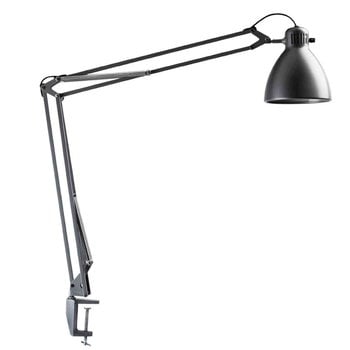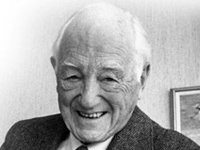Luxo’s L-1 desk lamp is the original architect lamp designed in 1937 by Jac Jacobsen. The L-1 LED features a dimmable, energy efficient LED module with an automatic shut-off timer. The unique design, ingenious lighting properties and flexible spring-balanced arm have earned the L-1 desk lamp a place among the world’s all-time classics. L-1 is a prime example of how versatility, quality and stylish design produce a product of long-lasting popularity. L-1 has been distinguished by many prestigious design awards and it still fills all the requirements of a functional desk lamp: the adjustable arm allows you to direct the light into the desired angle, and the simple, timeless design suits all types of décors.
L-1 LED desk lamp, aluminium grey
Luxo
Description
Luxo’s L-1 desk lamp is the original architect lamp designed in 1937 by Jac Jacobsen. The L-1 LED features a dimmable, energy efficient LED module with an automatic shut-off timer. The unique design, ingenious lighting properties and flexible spring-balanced arm have earned the L-1 desk lamp a place among the world’s all-time classics. L-1 is a prime example of how versatility, quality and stylish design produce a product of long-lasting popularity. L-1 has been distinguished by many prestigious design awards and it still fills all the requirements of a functional desk lamp: the adjustable arm allows you to direct the light into the desired angle, and the simple, timeless design suits all types of décors.
Product details (19)
- Material
- Aluminium, steel
- Colour
- Grey
- Length
- 104 cm
- Width
- 16 cm
- Diameter
- 16 cm
- Light source
- Fixed 8W LED (included)
- Colour temperature
- 3,000 K
- Luminous flux
- 700 lm
- Lifetime
- 50,000 h
- IP rating
- 20
- Protection class
- II
- Voltage
- 220–240 V
- Nominal frequency
- 50–60 Hz
- Certifications and labels
- CE marked: tested and approved according to European standards
- Plug
- EU plug
- Integrated switch
- Yes
- Dimmable
- Yes
- Notes
- Auto shut-off 4 or 9 hours. Table clamp for max. 5.5 cm thick tabletop included, base sold separately.
- Warranty
- 5 years
- Product ID
Designer
Jac Jacobsen (1901-1996) was the founder of Luxo, which has been a prominent supplier of luminaires for over 70 years. In 1934 Jac Jacobsen laid the basis for a company that today manufactures lighting solutions in three countries and has sales units throughout Europe, the USA and Canada.
Jac Jacobsen started his business importing textile machinery. After some years, the company also comprised three other sectors; lighting, ventilation and Venetian blinds. Today, focus is given to the lighting sector only. In 1936 Jac Jacobsen received two crane-like spring balanced “monster” luminaires included in a shipment of sewing machines from England. Supposedly, these luminaires were sent to help operating the machines. Being technically minded, Jac Jacobsen took a fancy to the strange looking luminaires, and contacted the supplier in England to get the distributorship for Norway. It was given on the condition that he bought mechanical parts for 500 luminaires – a substantial number at the time – and that he obtained product approval by the Norwegian safety authorities. Although the technical invention comprising the luminaire arm was ingenious, the luminaire construction as a whole was primitive and had to be improved a great deal by Jac Jacobsen before being approved and presented to the market. He succeeded – and manufacturing started in Oslo in the autumn of 1938. He derived the name LUXO from Latin – “I give light”. Jac Jacobsen saw the great functional and timeless beauty of this luminaire, and he successively obtained license to produce and market the product in all countries outside the Commonwealth. Nearly 70 years later, the original version of the Luxo architect luminaire, L-1, is still in production, and more than 25 million Luxo luminaires have been sold worldwide. Jac Jacobsen lived to be 95 years old and was active in the company until his last days.
View all productsReviews (0)
Sustainability
The Product Sustainability Framework, our criteria of sustainable design, helps you find the most sustainable products in our selection. Read below which sustainability criteria this product has met.
Working conditions & labour 8/9
-
Equal opportunities for all employees
-
Commitment to UN Global Compact, fair compensation for all employees
-
Corporate responsibility requirements defined and communicated for suppliers
-
Systematic work for improved inclusion and well-being in the workplace
-
Transparent supply chain
-
Suppliers' compliance to a code of conduct ensured
-
Direct suppliers audited and certified
-
Compliance to the UN Guiding Principles on Business and Human Rights ensured in the supply chain
-
Support for community involvement in the supply chain
Eco-friendly production 8/9
-
Fair and resource-wise water-use in production
-
No incineration or landfilling of returned items
-
No use of endangered species as materials
-
No direct environmental emissions or waste (excl. GHGs) from production
-
The sustainability of direct suppliers' production is addressed and monitored
-
Production and material sourcing that respect biodiversity, animal rights, and natural ecosystems
-
Material-efficient and ecological packaging
-
No potentially harmful chemicals used in own production
-
Positive impact on nature’s well-being through operations that regenerate natural ecosystems
Climate impact 4/8
-
Company's direct greenhouse gas emissions identified and commitment to reduction
-
Product's carbon impact identified and commitment to reduction
-
Guidance on energy- and eco-efficient use of the product
-
100 % renewable energy in own production and operations
-
Contribution to climate initiatives beyond the brand’s direct operations
-
Low-carbon or compensated transportation
-
Carbon footprint of the product calculated and goals set to reduce it
-
Carbon neutral or carbon negative product
Sustainable materials 5/6
-
Sustainable and long-lasting material choices
-
No harmful or hazardous substances
-
Responsible raw material sourcing and production
-
Materials suited for circularity: monomaterials, recyclable finishings, renewable or recycled contents etc.
-
Ecological materials: natural, biodegradable, recyclable or recycled contents
-
Outstanding materials in terms of innovativeness, responsibility, sustainability and circularity: local production or sourcing, 100 % recycled content, C2C-certification etc.
Circular design 4/5
-
High aesthetic quality promoting long-term use of the product
-
Technically durable product design and material choices
-
Design for enduring life-long quality
-
Design and support for product maintenance, repair and upgradability
-
Innovative circular design solutions: circular service system, resale platform, remanufacturing, collection of used products, etc.







